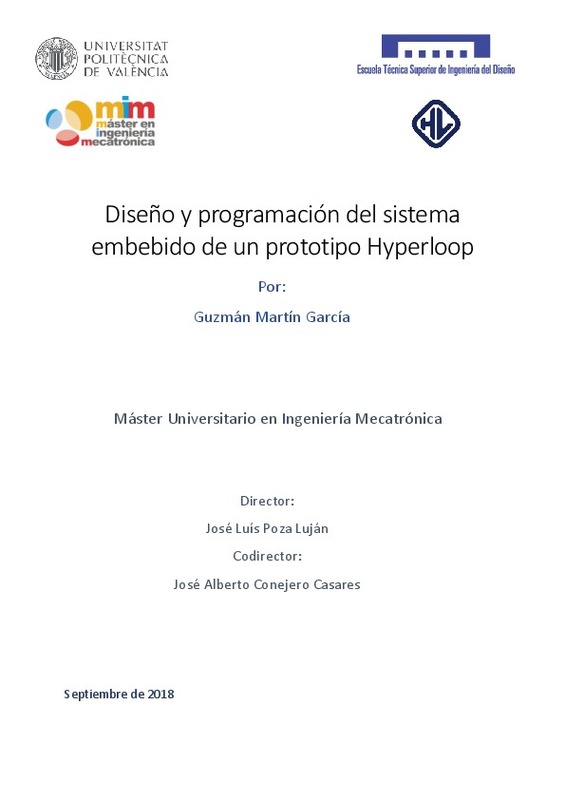JavaScript is disabled for your browser. Some features of this site may not work without it.
Buscar en RiuNet
Listar
Mi cuenta
Estadísticas
Ayuda RiuNet
Admin. UPV
Diseño y programación del sistema embebido de un prototipo Hyperloop
Mostrar el registro sencillo del ítem
Ficheros en el ítem
| dc.contributor.advisor | Conejero Casares, José Alberto
|
es_ES |
| dc.contributor.advisor | Poza Luján, José Luis
|
es_ES |
| dc.contributor.author | Martín García, Guzmán
|
es_ES |
| dc.date.accessioned | 2018-11-02T08:57:57Z | |
| dc.date.available | 2018-11-02T08:57:57Z | |
| dc.date.created | 2018-09-19 | |
| dc.date.issued | 2018-11-02 | es_ES |
| dc.identifier.uri | http://hdl.handle.net/10251/111733 | |
| dc.description.abstract | [ES] Hyperloop es un concepto de medio de transporte ideado por Elon Musk que contempla vehículos empleando sistemas de levitación viajando en tubos parcialmente al vacío, minimizando así tanto el rozamiento con el suelo como el rozamiento con el aire y permitiendo en tierra velocidades únicamente alcanzables por los aviones. En este contexto, el equipo Hyperloop UPV, se presenta a una competición anual en la que distintas universidades compiten por conseguir hacer el mejor prototipo de este medio de transporte. El objetivo de este Trabajo de Fin de Máster es describir el proceso de diseño, especialmente a nivel del software, del sistema embebido que controlará el prototipo que se presentará en la competición del 2018. El proyecto parte de los requisitos de la competición (en este caso, alcanzar la mayor velocidad posible), y una vez se ha definido el sistema mecánico y eléctrico por los otros departamentos del equipo, y los requisitos en cuanto a sensorización y control, se diseña una arquitectura en la cual se basará el software encargado de controlar el vehículo (ya que debe de ser completamente autónomo), transmitir toda la información posible a una estación base del equipo con su propio software de telemetría, y a un servidor de SpaceX que empleará para comprobar los datos medidos por ellos mismos. Se prestará énfasis especial en la seguridad y robustez | es_ES |
| dc.description.abstract | [EN] Hyperloop is a transportation method concept devised by Elon Musk, that consists in vehicles that travel inside pressurized tubes using different levitation systems, thus minimizing the aerodynamic and rolling drag, being able to achieve speeds only comparable to aeroplanes. In this context, the Hyperloop UPV team participates in an annual competition, in which universities all around the world compete to build the best prototype for this transportation method. The objective of this Final Thesis is to describe the design process, with special focus into the software, of the embedded system that will control the prototype that will compete in the 2018 competition. The thesis begins with the requisites of the competition (in this case, achieving the highest possible speed), and once the mechanical and electrical systems have been defined and the different sensors and control systems are chosen, an architecture is designed, which will be the base for the software that will control the vehicle (as it has to be completely autonomous), transmit as much data as possible both to a base station controlled by the team (which runs its custom software in charge of displaying telemetry data) and to a SpaceX server that will check the data measured by the team with their own. Special emphasis will be focused towards safety both from the hardware and software points of view, as it is one of the most important requisites to SpaceX | es_ES |
| dc.format.extent | 65 | es_ES |
| dc.language | Español | es_ES |
| dc.publisher | Universitat Politècnica de València | es_ES |
| dc.rights | Reconocimiento - No comercial - Sin obra derivada (by-nc-nd) | es_ES |
| dc.subject | Programing | es_ES |
| dc.subject | Sistema embebido | es_ES |
| dc.subject | Hyperloop | es_ES |
| dc.subject | Software | es_ES |
| dc.subject | Programación | es_ES |
| dc.subject | Embedded system | es_ES |
| dc.subject.classification | MATEMATICA APLICADA | es_ES |
| dc.subject.classification | ARQUITECTURA Y TECNOLOGIA DE COMPUTADORES | es_ES |
| dc.subject.other | Máster Universitario en Ingeniería Mecatrónica-Màster Universitari en Enginyeria Mecatrònica | es_ES |
| dc.title | Diseño y programación del sistema embebido de un prototipo Hyperloop | es_ES |
| dc.type | Tesis de máster | es_ES |
| dc.rights.accessRights | Abierto | es_ES |
| dc.contributor.affiliation | Universitat Politècnica de València. Departamento de Informática de Sistemas y Computadores - Departament d'Informàtica de Sistemes i Computadors | es_ES |
| dc.contributor.affiliation | Universitat Politècnica de València. Escuela Técnica Superior de Ingeniería del Diseño - Escola Tècnica Superior d'Enginyeria del Disseny | es_ES |
| dc.description.bibliographicCitation | Martín García, G. (2018). Diseño y programación del sistema embebido de un prototipo Hyperloop. Universitat Politècnica de València. http://hdl.handle.net/10251/111733 | es_ES |
| dc.description.accrualMethod | TFGM | es_ES |
| dc.relation.pasarela | TFGM\93151 | es_ES |
Este ítem aparece en la(s) siguiente(s) colección(ones)
-
ETSID - Trabajos académicos [8900]
Escuela Técnica Superior de Ingeniería del Diseño






